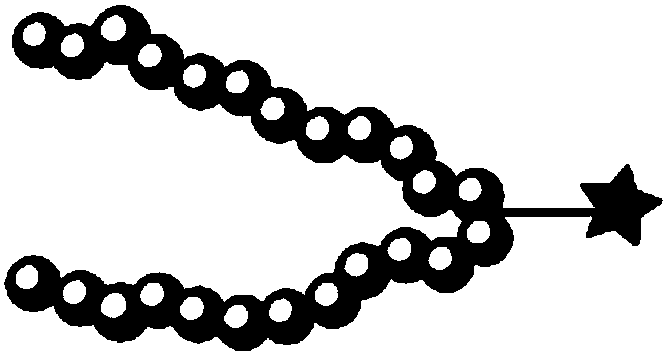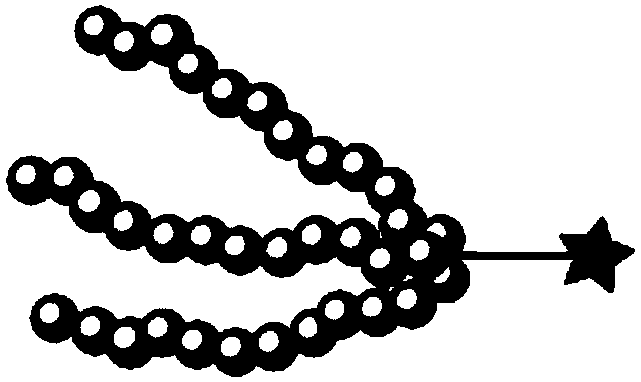Self-repairing graft copolymer based on hydrogen bond action and preparation method of self-repairing graft copolymer
A technology of graft copolymer and hydrogen bond, which is applied in the field of thermoplastic elastomer, self-healing graft copolymer and preparation based on hydrogen bond, which can solve the problem of high requirements and the lack of self-healing function of thermoplastic superelastomer materials, etc. problems, to achieve the effect of high elastic recovery rate, mild reaction conditions and good mechanical strength
- Summary
- Abstract
- Description
- Claims
- Application Information
AI Technical Summary
Problems solved by technology
Method used
Image
Examples
Embodiment 1
[0067] 1) The polymer macromonomer whose end group is a double bond is prepared: the preparation process of the poly-2-acetamidomethyl acrylate macromonomer of the single-tail structure is as follows:
[0068] First, the macromolecular initiator is prepared by atom transfer radical polymerization, and the specific process is as follows: Weigh 0.13 g of the initiator 2-bromopropionate ethyl ester, 0.12 g of the catalyst cuprous bromide, and the ligands N, N, N, N , N-pentamethyldivinyltriamine 0.12g, 2-acetamidomethyl acrylate 5g, N,N-dimethylformamide 15g, and the above-mentioned reactants were added to the reactor, and the reactants in the reactor were After deoxygenation treatment, it was sealed, and then the reactor was transferred to an oil bath at 100°C. After 8 hours of reaction, a bromo-terminated poly-2-acetamidomethyl acrylate macromolecular initiator with a molecular weight of about 6400g / mol was obtained. .
[0069] Take respectively 4g of the bromo-terminated poly...
Embodiment 2
[0073] 1) The preparation of terminal groups is a polymer macromonomer with a double bond: the preparation process of the poly-2-acetamidomethyl acrylate macromonomer of the double-tailed structure is as follows:
[0074] Firstly, the macromolecular initiator is prepared by atom transfer radical polymerization, and the specific process is as follows: Weigh 0.2 g of the initiator 2-bromopropionate ethyl ester, 0.1 g of the catalyst cuprous bromide, and the ligands N, N, N, N , N-pentamethyldivinyltriamine 0.12g, 2-acetamidomethyl acrylate 5g, N,N-dimethylformamide 15g, and the above-mentioned reactants were added to the reactor, and the reactants in the reactor were Seal it after deoxygenation treatment, then transfer the reactor to an oil bath at 100°C, and react for 8 hours to obtain a bromo-terminated poly-2-acetamidomethyl acrylate macroinitiator with a molecular weight of about 4500g / mol .
[0075] Take 4g of bromo-terminated poly-2-acetamidomethyl acrylate macroinitiator...
Embodiment 3
[0079] 1) The polymer macromonomer whose terminal group is a double bond is prepared: the preparation process of the poly-2-acetamidomethyl acrylate macromonomer of the three-tail structure is as follows:
[0080]First, the macromolecular chain transfer agent is prepared by reversible-addition-fragmentation chain transfer polymerization, and the specific process is as follows: Weigh the chain transfer agent 2-(dodecyltrithiocarbonate)-2-methylpropionic acid 0.6g, 5g of 2-acetamidomethyl acrylate, 0.11g of azobisisobutyronitrile, 40g of N,N-dimethylformamide, and the above-mentioned reactants used are added to the reactor, and the reactants in the reactor are After deoxygenation treatment, it was sealed, and then the reactor was transferred to an oil bath at 70°C. After reacting for 8 hours, a carboxyl-terminated polymethyl-2-acetamidoacrylate macromolecular chain transfer agent with a molecular weight of about 3100 g / mol was obtained.
[0081] Take 4g of carboxyl-terminated po...
PUM
| Property | Measurement | Unit |
|---|---|---|
| Tensile strength | aaaaa | aaaaa |
| Tensile strength | aaaaa | aaaaa |
| Tensile strength | aaaaa | aaaaa |
Abstract
Description
Claims
Application Information
 Login to View More
Login to View More - R&D
- Intellectual Property
- Life Sciences
- Materials
- Tech Scout
- Unparalleled Data Quality
- Higher Quality Content
- 60% Fewer Hallucinations
Browse by: Latest US Patents, China's latest patents, Technical Efficacy Thesaurus, Application Domain, Technology Topic, Popular Technical Reports.
© 2025 PatSnap. All rights reserved.Legal|Privacy policy|Modern Slavery Act Transparency Statement|Sitemap|About US| Contact US: help@patsnap.com



